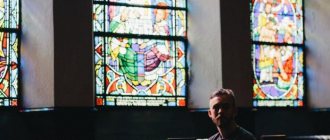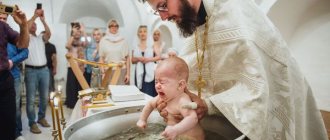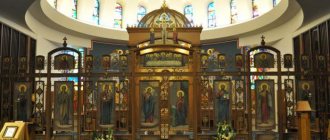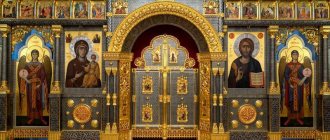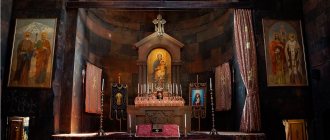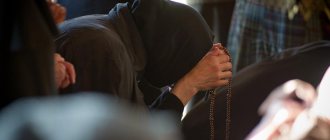In one of his famous plays, A. Chekhov argued that everything in a person should be beautiful: face, clothes, soul, and thoughts. It is difficult to disagree with him, since true respect is earned by a person whose actions, words and behavior correspond to this requirement. Everyone is obliged to follow the rules of good manners, regardless of age, skin color, gender, religion. It is worth paying special attention to the last point, since there are certain rules for believers that represent Christian etiquette
.
God has always been a central figure in the life of a Christian. In the recent past, people always began mornings, evenings, even meals with prayer. Today, many rules that the church
, are ignored by society.
But even a person who does not pray or attend church
. According to the clergy, there is no great sin in this, the main thing is that the person’s thoughts and actions are pure and he lives according to the laws of God.
Upon entering the temple
When approaching an Orthodox building, you need to look up at the domes and crosses, and then cross yourself three times. Having done this, bow (at the waist). It is recommended to consolidate these actions with the publican’s prayer. In order not to offend God by your behavior, it is prohibited:
- to swear;
- smoke;
- going to the temple while drunk;
- take animals with you.
Now you need to go up to the porch of the temple, pause for a moment and cross yourself three times again. It is better not to neglect bowing (as well as the sign of the cross). The rules also require stopping at church doors. Here you must bow three times and read the “Our Father.” Try to abandon vain thoughts and concentrate on spiritual things. In the temple itself, think about the bright, avoid despondency. You should not pray for show—say the sacred words mentally.
Religious etiquette.
Various religions and denominations establish rules that are mandatory for believers—religious norms. They are contained in religious books (Old Testament, New Testament, Koran, Sunnah, etc.), in decisions of meetings of believers or clergy, in the works of authoritative religious writers. These norms determine the order of organization and activities of religious associations, regulate the performance of rituals, and the order of church services.
Religious norms.
A number of religious norms have moral content (commandments). There have been entire eras in the history of law when many religious norms were of a legal nature and regulated certain political, state, civil, procedural, marriage and other relations. In some modern Islamic countries, the Koran (“Arabic code of law”) and the Sunnah are the basis of religious, legal, and moral norms that regulate all aspects of a Muslim’s life, defining the “right path to the goal” (Sharia). In Christian countries, the church no longer has such totalitarian influence. We can choose for ourselves whether to believe in God or not, to convert or to remain aloof.
For a believer, religious etiquette requires compliance with many norms, such as:
1. keeping the commandments; 2. regular church attendance; 3. daily prayers; 4. observance of church holidays and fasts; 5. carrying out certain life events (baptism, wedding, funeral) according to church canons; And so on.
Sometimes the norms of religious etiquette come into conflict with the norms regulating other spheres of human life. For example, the day of a church holiday, on which you are not supposed to work, does not always coincide with a calendar day off. Also, you can’t go into church in just any clothes. In such cases, you need to look for a reasonable compromise.
Visiting church.
The church is a stronghold of religious norms; everything under its arch is subject to strict rules and canons. Even those Orthodox Christians who are not very zealous in observing religious norms attend church from time to time. The need or need for this has arisen at least once in every person’s life.
Here is what church officials say about the requirements for church visitors:
1. Before coming to church.
It is strictly forbidden to come to the temple in a drunken state, or to bring or bring animals with you. Dress modestly to attend church. Your clothing should be decent and neat. Do not hang decorations on yourself, especially jewelry. Do not dress in short dresses and skirts, shorts and clothes with short (above the elbow) sleeves, T-shirts and beach suits.
Women must wear women's clothing. When going to the House of God, do not put on makeup on your lips and face, and do not anoint yourself with even faintly smelling colognes or perfumes. Women are not supposed to attend church when they are unclean as women: from the first day until they are completely cleansed. On the way, forget about worldly vanity and pettiness, calm down if you are irritated. You must come to the Divine Service in advance, 10-20 minutes in advance, to buy candles, venerate icons, relics or some other shrines of the temple.
At the entrance to the temple grounds, three Signs of the Cross are placed. Before performing them, the man must remove his headdress. (Having crossed himself, a man can put on a hat if it is far from the entrance to the temple building itself and it is very cold outside, for some other reason). Women do not take off their headdresses, but on the contrary, they must cover themselves before the Sign of the Cross and not take it off. The signs of the cross are performed without gloves, mittens, etc., with bows from the waist, if there is no fasting. The signs of the Cross with prostrations are included in the fasts.
2. On the territory.
On the territory of the church, and especially in the temple, you are prohibited from: smoking, littering, talking and laughing loudly, desecrating the territory by spitting and blowing your nose. Walking animals on the temple grounds is strictly prohibited. Photo and video filming, as well as audio recording, can only be done with the blessing (permission) of the abbot.
3. In the temple. In the temple you cannot talk or laugh loudly, keep your hands in your pockets or behind your back, eat, suck candy, or chew. Do not stand with your back to the Altar. Do not walk around the temple unless necessary. You need to light candles and venerate icons in such a way as not to disturb other worshipers. Conversations should be limited to the limit. In the temple, it is customary to greet acquaintances with a slight bow, postponing conversations for later, and it is not customary to shake hands. When you come to church with children, you should not allow them to run around, play pranks and laugh. A crying child must be immediately calmed down or taken out (carried out).
You can only sing along with the choir very quietly, so as not to disturb others. During public singing, do not allow “disorderly screaming.” Sitting in the temple is allowed only due to illness or severe fatigue. At the same time, do not cross your legs. This is considered very indecent. It is strictly forbidden to walk and talk while reading the Gospel, singing the “Cherubic” and the Eucharistic canon at the Liturgy (that is, from the Creed to the “Our Father”).
You need to make comments to a neighbor who has violated the rules of conduct quietly and delicately. But the best thing is to refrain from making comments to anyone. Better watch yourself. You cannot leave the church until the end of the service. You can leave ahead of time only due to weakness or serious necessity. When leaving the Divine Service, you need to make the Signs of the Cross when leaving the temple and when leaving the church gate, turning your face to the temple.
It should be remembered that in the church environment it is customary to treat the use of a proper name in the form in which it sounds in Church Slavonic. That’s why they say: “Father John” (not “Father Ivan”), “Patriarch Alexy” (and not “Alexey”).
When dealing with the clergy, one should strive for a neutral style of speech. Thus, the address “father” (without using a name) is not neutral. It is either familiar or functional (characteristic of the way clergy address each other: “Fathers and brothers, I ask for your attention”). The question of what form (to “you” or “you”) should be addressed in the church environment is decided unambiguously - to “you” (although we say in prayer to God Himself: “leave it to us”, “have mercy on me” ).
The deacon is the priest's assistant. He does not have the grace-filled power that a priest possesses and which is given in the sacrament of ordination to the priesthood. A deacon cannot independently, without a priest, serve the liturgy, baptize, confess, unction, crown (perform the sacraments), perform a funeral service, or consecrate a house (perform religious services). Accordingly, they do not turn to him with a request to perform sacraments and services and do not ask for a blessing. But, of course, a deacon can help with advice and prayer. The deacon is addressed with the words: “Father Deacon.”
It is not customary in church practice to greet a priest.
with the words: “Hello,” “Good afternoon,” and they say: “Bless you!” At the same time, if they are next to the priest, they fold their palms to receive a blessing (right over left). The priest, when pronouncing the words: “God bless” or “In the name of the Father, and the Son, and the Holy Spirit,” makes the sign of the cross on the layman and places his right hand on his palm, which the layman kisses.
For lay men, there is another type of blessing: the person receiving it kisses the hand, cheek, and again the hand of the priest. Although the variability of the blessing gesture does not end there: the priest can place the sign of the cross on the bowed head of a layman with the laying on of his palm, or he can bless from a distance. A common mistake made by people with little church life is to apply the sign of the cross to themselves before taking a blessing from a clergyman (“to be baptized by the priest”). Asking for a blessing and giving it are the most common realities of church etiquette.
Icons in the house.
Every believer should have at least one icon in their home. How many icons there will be, and what they will be like is everyone’s personal matter. For faith, both the simplest paper icons and valuable ancient icons in an expensive setting are equal. The icon should occupy a place of honor in the house. There has long been a rule: hang icons in the red corner. It's directly to the right as you enter the room. If water pipes are in the way (and the proximity of hot pipes causes wood to warp and paints to crumble), you need to make shelves for icons.
It is extremely undesirable for icons to be next to a TV, and a refrigerator is not the most suitable option. But if there is no other way out, then you can put the icon on the refrigerator. The main thing is to arrange the place accordingly. Due to lack of space in the red corner, the icons can be placed simply on the wall. Icons should be in all rooms of the apartment.
In the temple
Usually the beginning of the service is marked by the ringing of bells - 15 minutes before it you should already be standing in the church building.
During the service it is permissible to purchase candles; everything else (crosses, books, icons) must be purchased in advance. It is considered bad manners to distract parishioners praying in the temple, to look at them, to place candles in front of each icon. If you visit a temple when an important religious event is being celebrated, try to kiss the main icon. You need to kiss the edge of the image, after crossing yourself. Applying lipstick to icons is strictly prohibited.
If you behave correctly in church, you will not disturb other believers. The set of rules prescribes greeting acquaintances quietly and not making noise. Try not to ask unnecessary questions in the church - this can be done after the service. The use of mobile phones and cameras is also prohibited inside the temple. According to the current rules in the church you cannot:
- talk loudly;
- reach into pockets;
- holding hands;
- chew;
- laugh.
If you go to church with children, make sure they do not make noise. A small child inside the temple may throw a tantrum. In this case, you should leave the church building with your baby. You should also not give your offspring food in an Orthodox church - this is bad form.
Also, you should not move around the temple during the service. As you pass by the Royal Doors, cross yourself.
Sitting during the service is strictly prohibited. Clergy may view such behavior as signs of disrespect. There can be only one exception - if you have health problems. When reading the Gospel, it is necessary to stand. The same applies to the key points of the Liturgy.
Religious norms.
The main meaning of most religious norms is their moral content; let us remember the commandments. History remembers times when religious norms had equal rights with legal ones. They were the basis of state and political regulation and served as a powerful argument in legal, procedural and family relations.
Each religion has its own set of rules - religious norms that form the basis of religious etiquette. Religious norms are described in the holy books: the Old and New Testaments, the Koran, and so on, depending on religion. In addition, they are contained in various spiritual literature. These norms regulate all activities of religious communities; they describe how rituals should be performed and what is the procedure for conducting church services.
In some Muslim countries and in our time, the Koran and Sunnah regulate not only religious norms, but also other aspects of life: legal and moral. The Orthodox Church now does not have that much influence in Christian countries. Every person has the right to decide for himself whether to believe in God or not, to observe church canons or not.
According to the rules of religious etiquette, every believer must observe certain norms, namely: not break the commandments, constantly attend church, pray every day, observe church holidays and fasts. And all important events in life: baptism, wedding, funeral, must be carried out strictly according to church rules.
Religious etiquette and religious norms are strict regulations. But there are cases when they contradict the norms of the state and society. Let's take for example a situation where a major church holiday coincides with a weekday calendar day. Or you need to go to church, but your clothes do not correspond to church etiquette. If desired, you can always find a compromise solution to these inconsistencies.
Appeals to priests and laity
During a visit to an Orthodox sanctuary, it may be necessary to communicate with laypeople or a priest. If you see the mistakes of the laity, do not ridicule them - it is a sin to notice the shortcomings of others. The rules allow for delicate remarks in a low voice - and nothing more.
You cannot shake hands with a priest when meeting him - this is the prerogative of other ministers equal to him in rank. In temples it is customary to place your palms together and wait patiently for the blessing. Humbly bow your head, kiss the right hand of the minister. If you are overshadowed by a sacred object (Chalice, Gospel, icon), cross yourself, and then bow to the priest.
How to contact Christians
People professing Christianity
, should know that observing Orthodox etiquette presupposes not only the ability to behave properly in church, but also the ability to address the people there.
If you can address a passerby on the street by indicating his gender (woman/man, boy/girl), then in relation to a parishioner this will be a demonstration of one’s lack of culture. The Church
encourages the use of more cordial addresses: sister (if you want to call out to a girl), mother (when addressing a woman). Young men are called brothers, more mature men are called fathers.
Priests in the Orthodox community are called priests and fathers. The name of the clergyman is often added to the latter. True, you need to use Church Slavonic names, and not those indicated in official documents: “father” or “father John” (but not Ivan).
An important difference between Christian etiquette and business etiquette is the possibility of clergy addressing each other on a first name basis. It is preferable for parishioners to use the you-form. Despite the fact that Christians address the Lord as the closest person to “you” (Lord, save; God, have mercy on us; Thy kingdom), you-form in relation to the servants of the temple is considered more delicate and does not hurt the ears.
Moral standards and etiquette rules apply everywhere - in secular society, in a business environment, in sports. etiquette in the world , which is called religious. Orthodox churches, cathedrals, temples, and other sacred buildings are special places, on the territory of which their own rules apply. To violate the prohibitions of the church is to offend its holiness. A person who considers himself Orthodox is obliged to honor Christian laws and regulations. This is a special world, where everyone can become a little kinder and more humane.
Blessing of the Priest
A believer considers a blessing an important parting word and tries in every possible way to receive it. Deacons do not bless the laity; you should not approach them with such requests. In churches, deacons and bishops are easily distinguished by their vestments. When a clergyman blesses a layman, this can be interpreted as a greeting, parting word, or permission. Father blesses in various life situations:
- business trip;
- beginning of fasting;
- Exams passage;
- job interview.
Feel free to ask for guidance in difficult life situations, when traveling long distances or making a responsible decision. There is an important rule: if there are several priests standing nearby, first approach the one who has a higher rank. It is not recommended to contact the bishop during ritual actions (communion, anointing with oil). You need to address the clergyman with the words “Father, bless.”
Candle
For many, visiting a temple begins with a candle box. You will have to place the candles in the sockets of church candlesticks; you can do this with either hand. It happens that during major celebrations, the clergyman exchanges your candles for offerings from other people. You should not be offended - your actions have already been marked by the Lord. There are no strict rules on the number of lit candles - each parishioner decides this issue for himself. Experienced believers leave candles in different places:
- on the lectern (a candle is not placed here, it must be placed without lighting);
- in front of the festive icon;
- near the image of the Virgin Mary (the second option is the Savior);
- on the eve next to the crucifix (rectangular table);
- next to the icon of the beloved saint.
Do not try to place candles near each icon - the rules of conduct in the church do not encourage such actions. The burning of a believer’s heart is more important to the Lord than the flame of many candles. So pray sincerely in front of the icons and remember that in churches a candle is a symbol of grace.
Orthodox etiquette - clothing of believers
Etiquette
requires compliance not only with standards of decency, but also with the rules of wearing clothes.
According to the rules of Christian etiquette, it is forbidden to come to church in colorful, provocative outfits. It is preferable to wear clothes of a single color. You should also not choose sportswear. The outfit should be modest, not exposing the human body. The image should not be bright - it is better to avoid jewelry. Church
is not a place to show off your attire. Violation of this prohibition indicates that the person who comes to the temple is not thinking about God, but about attracting attention to himself. Representatives of the stronger sex should remove their hats before entering the temple. Ladies are forbidden to wear cosmetics and enter the sacred place with their heads uncovered. Ladies are also forbidden to dress in men's suits: it is unacceptable to come to church in trousers, jeans, or shorts.
According to the clergy, these rules should be followed not only in church. A true Christian must remain a Christian everywhere. This does not mean that women should always wear dresses and scarves. We are talking about observing a certain minimum of rules, which cannot be crossed. To do this, you should listen to your inner voice.
Icons
When you enter the temple and see the holy icons in front of you, imagine how the saints with the Lord at their head are looking at you from heavenly heights. There are certain rules for the veneration of holy relics and images by believers - these instructions must be followed in the temple. Here are some basic recommendations:
- When approaching the icon located inside the temple, cross yourself twice.
- Kiss the holy image once (you need to kiss the corner, not the center).
- Cross yourself a third time.
- Go away, do not delay other believers.
There are exceptions to any rule. In some churches, waist-length images are displayed - then you need to venerate the blessing hand of the saint. If the icon depicts the crucified Savior, you need to kiss his feet; for images not made by hands, the hair is most revered. But the most common mistake of beginners is kissing the holy face. If you want to receive healing, you should turn to miraculous icons.
Bows and Sign of the Cross
So, approaching the temple, you must bow and cross yourself. But even inside the church building, these actions are repeated in certain situations. During the service, bow and cross yourself synchronously with other believers. When praising Jesus and the Trinity, you need to create the holy cross, the same action is repeated when shouting “Give, Lord” or “Lord, have mercy.”
When finishing or starting to read the prayer, be sure to cross yourself. Before installing a candle or approaching the icon, you should bow. The sign of the cross must be applied slowly, without haste that is inappropriate in the church. Here are recommendations for the proper application of a cross:
- You need to use your middle, index and thumb.
- A cross is applied with the right hand.
- First, the fingers touch the forehead, then the stomach, right and left shoulders.
- The action ends with a bow from the waist.
At the exit from the temple
If you gave the clergy a note, go to the candle box after the service. Receive the ritual wheat bread (prosphora) in which the message was placed. Take the bread home to enjoy it in peace with holy water. The prosphora must be eaten on an empty stomach, accompanying the action with the offering of prayer.
Please note: after the service in churches, prayer services begin - special prayers that mention your needs. This is the right path to receiving God's help. A farewell prayer is recommended for wanderers. There are also national prayer services - New Year's, during drought and bad weather. If your goal is achieved, it is worth offering a prayer of thanks.
You must leave the church with bows and three prayers. If a beggar is found on the porch asking for alms, he should be helped. Good deeds will count in heaven.

